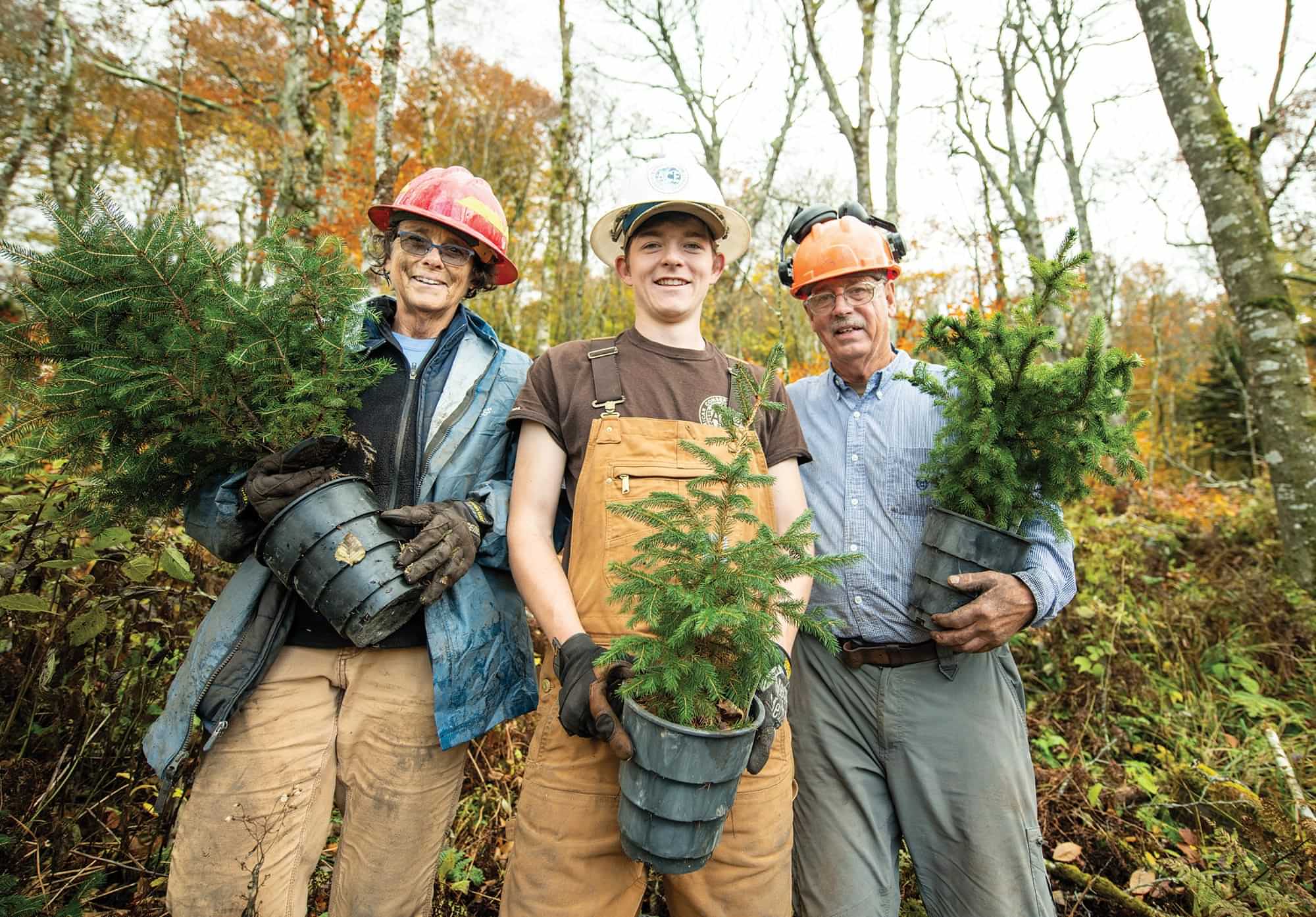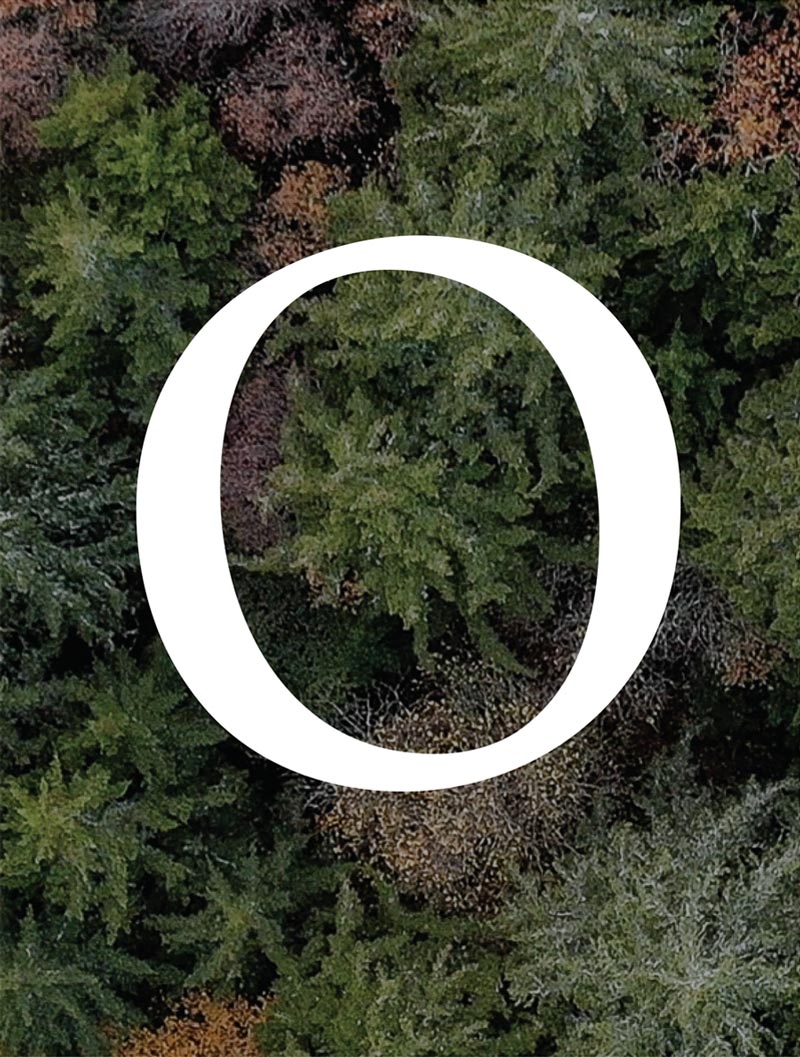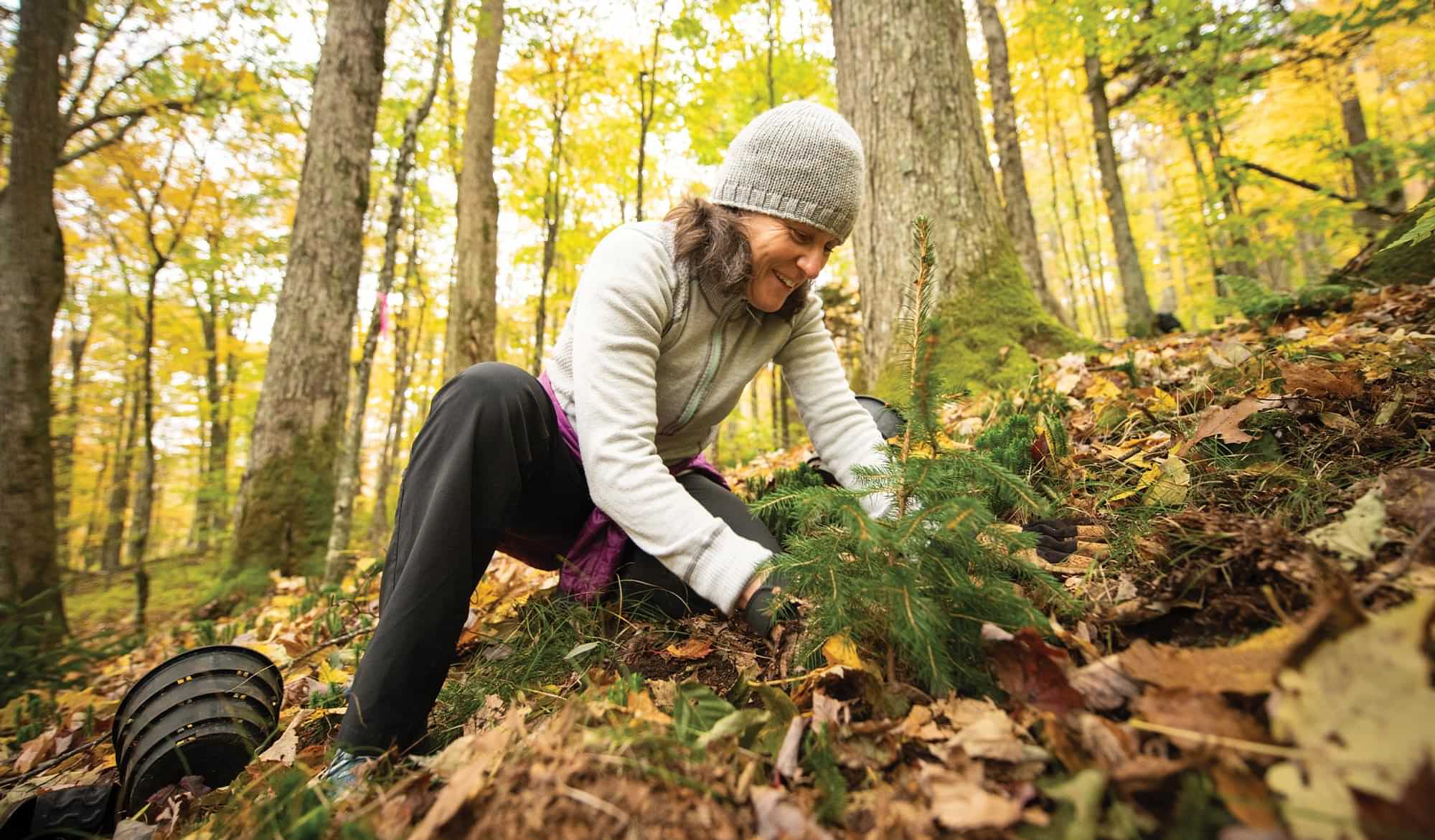Saving
Islands in
the Sky
An iconic tree of the Southern Appalachians, the red spruce, is the focus of a longterm effort to preserve one of the most endangered habitats in North America — and a distinct A.T. experience.


n a golden October day, a dozen or so people headed off trail through an Appalachian forest. They climbed higher and higher, their boots crunching the leaf litter beneath them. Trees soared above their heads, many of them hardwoods, with leaves flashing amber and red.
Each person in the group had a different degree of familiarity with this section of woods, and a different amount of conservation experience. But they were united by what they carried in their hands — red spruce seedlings, none more than two feet tall — and their mission: to help restore the red spruce forest in the southern Appalachian Mountains.
A relic species of the last Ice Age that thrives in colder temperatures, the red spruce was once a mainstay of the eastern North American forest from the southern Appalachians to coastal Canada. However, in the 19th and early 20th centuries widespread logging cut its historic range in half. This made the remaining forests vulnerable to wildfires that burned with such intensity that they destroyed the very organic matter that spruce trees need for their seeds to sprout. In a warmer climate, red spruce in the southern Appalachians now exist mostly on the highest mountaintops, forming dark green “sky islands.” Further temperature increases will continue to stress the trees, making them more vulnerable to pests and wind disturbance events.
A stand of red spruce on Whitetop Mountain in southwestern Virginia stretches skyward. Photo by Chris Gallaway/Horizonline Pictures
Southern Appalachian forests are an ecological hotspot in the United States for species at risk of disappearing. Protecting biodiversity is essential to preserving human health and well-being, because healthy ecosystems ensure food and water supplies. Preserving the health of a single species, such as the red spruce, helps keep a complex ecosystem intact — benefiting human populations as well as plants and animals that rely on the spruce for their own survival.
Mature trees can grow between 60 to 130 feet tall, and some are as old as 350 years or more. But their hold on the landscape is tenuous. The trees are shade tolerant but only to a degree. When the tallest trees crowd the canopy, reducing light to the forest floor, smaller, younger spruce can suffer. For decades before the Clean Air Act, the species was susceptible to the effects of acid rain, and weak trees are also vulnerable to pests. Factor in other impacts of climate change and development — invasive species, more severe storms, habitat loss — and the red spruce is especially at risk.
“Sometimes spruce is its own worst enemy,” says Mark Ford, unit leader of the U.S. Geological Survey’s Virginia Cooperative Fish and Wildlife Research Unit, which is housed within the College of Natural Resources and Environment at Virginia Tech, and a frequent partner with ATC for forest restoration. “When it was exploited a hundred years ago, if the landscape didn’t burn, it would seed itself back in, but it would overdo it. It would seed itself in too densely. Trees are like everything else; they’ve got to have space and water and light. And so, throughout the southern and central Appalachians, there are stagnant, arrested stands of spruce trees that are anywhere from 40 to 80 years old that have just quit growing because there’s too much competition for resources.”


In late 2019, the ATC began working with SASRI partners like Ford at Virginia Tech, as well as researchers at Western Carolina University and Appalachian State University, to restore red spruce to parts of its historic range within the A.T. landscape. Together, they are focusing on places like Whitetop Mountain in Virginia and Roan and Unaka mountains in North Carolina and Tennessee — all well-known summits along the southern A.T.


The autumn tree planting took place on Whitetop Mountain, the second-highest peak in Virginia at 5,520 feet after nearby Mount Rogers (just 200 feet higher). Here, the A.T. is a province of open meadows and northern hardwood forests that give way to a fairyland of red spruce at its highest reaches. Songs of the winter wren, red crossbill, hermit thrush, and golden-crowned kinglet can be heard in these woods, rewarding patient birders. This part of southwest Virginia was heavily logged in the 1900s, and today much of the original spruce forests have been replaced with American beech, yellow birch, sugar maple, and other species.

Even with a dozen or so workers at any given time, it took the team at Whitetop in October a full week to get all the red spruce seedlings in the ground. Photo by Chris Gallaway/Horizonline Pictures

The group planted seedlings at a range of ages from two years old to eight, sourced from the Southern Highlands Reserve, a key SASRI partner. Funding for the seedlings came from the U.S. Fish and Wildlife Service and private donors to the ATC, including the Jean Deeds Red Spruce Forest Restoration Fund. To date, the October spruce event represents one of the largest planting efforts.
“Three-quarters of the red spruce plantings were in northern hardwood forest understory as opposed to treeless openings,” McBane says, “and now ATC will be monitoring the seedlings for viability. Spruce are somewhat shade tolerant, but only to a point. Each of the six planting sites will require maintenance and light overstory thinning to ensure the spruce aren’t being outcompeted in their early stages of life.”
The six sites all vary from each other in terms of shade, elevation, soil types, and density, and so now data can be collected to compare growth rates and determine what conditions are most favorable to recovering spruce on Whitetop Mountain. One of the plots, which now boasts 50 spruce saplings, is visible from the A.T. in the Elk Garden section of Whitetop, so hikers can do their part to watch these trees, too.
“From my perspective as a wildlife biologist,” Phillips says, “this forest is extremely important because it has species that are found nowhere else in the Southern Appalachians. From a recreational perspective, especially for those who don’t have a lot of outdoor experience, most of the Mount Rogers area looks a lot like what you see in your backyard if you live around here — lots of oaks and maples. And then you come up to the spruce forest, you’re just like, ‘Whoa, I didn’t know we had something like this in the South!’ It’s kind of like our own little slice of Canada.”
It’s important to the health and genetic diversity of endangered animals such as the flying squirrel, Phillips says, to build in connectivity between these spruce forest patches. “This way the endangered Carolina flying squirrel can move between these mountaintops, and we can get those populations to mix together, enhancing genetic diversity. We’re building a bridge.”
Some 70 miles south of Whitetop along the Trail, at Roan Mountain, the ATC coordinated a canopy gap project working with Dr. Beverly Collins of Western Carolina University and graduate student Thomas Hennessy. The team set up 6 plots with canopy gaps that were 10 feet in diameter and 6 plots with gaps 30 feet in diameter, as a way to measure growth response of spruce trees to such openings. Hennessy focused his thesis on this project, ultimately winning a Three-Minute Thesis award for his work. (Three-Minute Thesis is an annual competition for master’s students held at over 200 universities worldwide.)
Existing conditions on the mountain, Hennessy explained in his winning presentation, included unhealthy mature spruce trees and a moribund understory that lacked the nutrients and organic material ideal for regrowth. By removing mature trees from the centers of the plots, the gaps mimic more natural processes such as wind events that create forest gaps, allowing young spruce to grow and thrive.
“If we see a significant difference in the amount of ground cover, the amount of growth, and the amount of photosynthesis between the 30-foot openings we create and the 10-foot openings,” Hennessy says, “we may have found evidence for a process that land managers can use to help restore this threatened ecosystem site and help bring spruce back to the areas they once dominated.”
—Mark Ford, U.S. Geological Survey
The ATC and SASRI are also working with federal partners to secure National Environmental Policy Act compliance. This will be necessary for the team to undertake large-scale spruce restoration while demonstrating due diligence around removing individual trees to benefit an entire forest.
“I’ve actually never done work like this,” says ACE member Miles Taylor. “This is my first tree planting project, and it’s awesome! I’ve never worked with this many people either. It’s cool to see a bunch of different organizations come together to work on one thing.”
That is a sentiment echoed by the ATC’s Matt Drury. What he especially appreciates about this work is that it brings a diverse group — of hikers, land managers, young people, volunteers, and seasoned professionals — together to protect a forest type that creates one of the most memorable experiences one can have on the Appalachian Trail. “People may not know that they’re in a spruce forest, but when they’re there, they have a visceral, sensory experience,” he says.
Just as this spruce restoration work creates resilience and habitat connectivity, the data collected from these efforts also connects the dots for land managers across the red spruce’s range, so they can make the best decisions possible going forward and protect the Appalachian Trail landscape for generations to come.
“This is what the flying squirrel wants,” Mark Ford says. “This is what saw-whet owls want. This is what northern goshawks want. This is what the salamanders want. Every time you do little management things that restore red spruce, you increase the complexity and the heterogeneity of that little patch of forest, which all kinds of species can then key in on. And once one of those patches gets to a certain size, it’s much better equipped to deal with the impacts of climate change.”
Hikers who summit Whitetop, Roan, or Unaka mountains may never encounter any of the species that Ford named, but they know when they’ve entered the unforgettable, almost enchanted realm of red spruce. Many of the most distinct experiences across the entire A.T. are within areas of extraordinary ecological significance. The red spruce sky islands represent how critical habitats are necessary for the survival of a large array of declining species — and awe-inspiring to all of us who seek beauty and inspiration in nature.